中国传统文化介绍(英文版)
- 格式:pptx
- 大小:7.20 MB
- 文档页数:19
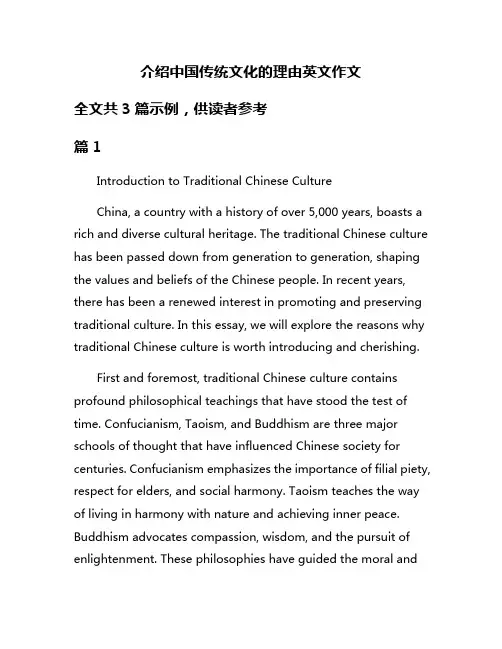
介绍中国传统文化的理由英文作文全文共3篇示例,供读者参考篇1Introduction to Traditional Chinese CultureChina, a country with a history of over 5,000 years, boasts a rich and diverse cultural heritage. The traditional Chinese culture has been passed down from generation to generation, shaping the values and beliefs of the Chinese people. In recent years, there has been a renewed interest in promoting and preserving traditional culture. In this essay, we will explore the reasons why traditional Chinese culture is worth introducing and cherishing.First and foremost, traditional Chinese culture contains profound philosophical teachings that have stood the test of time. Confucianism, Taoism, and Buddhism are three major schools of thought that have influenced Chinese society for centuries. Confucianism emphasizes the importance of filial piety, respect for elders, and social harmony. Taoism teaches the way of living in harmony with nature and achieving inner peace. Buddhism advocates compassion, wisdom, and the pursuit of enlightenment. These philosophies have guided the moral andethical behavior of the Chinese people for centuries, shaping their values and beliefs.Secondly, traditional Chinese culture is characterized by its emphasis on harmony and balance. The concept of yin and yang, which represents the dualistic nature of the universe, is central to Chinese philosophy. The idea of balance between opposites is reflected in various aspects of Chinese culture, such as traditional Chinese medicine, Feng Shui, and martial arts. Traditional Chinese medicine seeks to restore the balance of qi, or vital energy, in the body through acupuncture, herbal remedies, and other healing practices. Feng Shui is the art of arranging living spaces to promote balance and harmony. Martial arts, such as Tai Chi and Kung Fu, emphasize the balance of body and mind through disciplined practice.Furthermore, traditional Chinese culture is known for its rich artistic traditions, including calligraphy, painting, poetry, and music. Chinese calligraphy is considered a form of meditation and self-expression, with each brushstroke reflecting the artist's state of mind. Traditional Chinese painting often features landscapes, flowers, and birds, conveying the beauty of nature and the artist's emotional response to it. Chinese poetry is known for its lyrical beauty and emotional depth, with poets likeLi Bai and Du Fu achieving fame for their timeless verses. Traditional Chinese music, such as the guqin and pipa, is characterized by its soothing melodies and expressive qualities.In addition, traditional Chinese culture is renowned for its culinary traditions, which include a wide variety of dishes and cooking techniques. Chinese cuisine is characterized by its use of fresh ingredients, balanced flavors, and distinct regional styles. The art of Chinese cooking involves a combination of techniques, such as stir-frying, steaming, and braising, to create dishes that are both flavorful and visually appealing. Chinese food culture also emphasizes the importance of communal dining and sharing meals with family and friends, reflecting the value of hospitality and social harmony.In conclusion, traditional Chinese culture embodies a rich and diverse heritage that reflects the values, beliefs, and artistic achievements of the Chinese people. By introducing and cherishing traditional culture, we can gain a deeper understanding of Chinese history and society, as well as appreciate the beauty and wisdom of this ancient civilization. As China continues to modernize and globalize, it is essential to preserve and promote traditional culture as a source of inspiration and identity for future generations. Let us celebratethe legacy of traditional Chinese culture and ensure that it continues to thrive in the modern world.篇2Reasons to Introduce Chinese Traditional CultureChinese traditional culture, rich in history and customs, is an essential part of the world's cultural heritage. It represents the values, beliefs, and practices that have shaped Chinese society for thousands of years. There are several reasons why it is important to introduce and preserve Chinese traditional culture.Firstly, Chinese traditional culture is a valuable source of wisdom and inspiration. Throughout history, Chinese philosophers, scholars, and artists have produced profound insights into human nature, society, and the natural world. The teachings of Confucius, for example, emphasize the importance of moral integrity, social harmony, and filial piety. Traditional Chinese poetry, calligraphy, and painting reflect a deep appreciation of nature, beauty, and virtue. By studying and practicing these cultural traditions, people can gain a deeper understanding of themselves and the world around them.Secondly, Chinese traditional culture is a testament to the creativity and ingenuity of the Chinese people. From theinvention of paper and printing to the development of silk and porcelain, Chinese civilization has made significant contributions to human progress and innovation. Traditional Chinese medicine, martial arts, and cuisine are admired around the world for their effectiveness, elegance, and complexity. By preserving and promoting these cultural achievements, we can celebrate the achievements of past generations and inspire future generations to build on their legacy.Thirdly, Chinese traditional culture is a bridge to the past and a foundation for the future. By preserving and transmitting cultural traditions, we can connect with our ancestors and preserve the collective memory of our society. This continuity helps to create a sense of belonging and identity, providing a source of strength and resilience in times of change and uncertainty. By learning about our cultural heritage, we can better appreciate the values and principles that have guided our society for generations and gain insight into how we can shape a better future.In conclusion, Chinese traditional culture is a treasure trove of wisdom, creativity, and heritage that deserves to be preserved and passed on to future generations. By studying and practicing traditional Chinese customs, beliefs, and arts, we can gain adeeper understanding of ourselves and the world around us, celebrate the achievements of our ancestors, and create a more vibrant and inclusive society. Ultimately, the preservation of Chinese traditional culture is not only a matter of cultural pride but also a vital part of our shared human heritage.篇3IntroductionChinese traditional culture has a long history and rich heritage that has been passed down through generations. It encompasses a wide range of aspects including philosophy, literature, art, music, cuisine, medicine, and customs. In recent years, there has been a renewed interest in China's traditional culture both domestically and internationally. In this essay, we will explore the reasons why Chinese traditional culture is worthy of attention and preservation.1. A Reflection of Chinese HistoryChinese traditional culture is deeply rooted in the country's long and storied history. It reflects the values, beliefs, and principles that have shaped Chinese society for centuries. By studying traditional Chinese culture, we can gain a better understanding of the country's past, and how it has influencedthe present. From ancient philosophies such as Confucianism and Daoism to classical literature such as the poetry of Li Bai and Du Fu, Chinese traditional culture offers a window into the soul of the nation.2. A Source of Wisdom and InspirationChinese traditional culture is a wellspring of wisdom and inspiration. It offers valuable insights into human nature, morality, and the meaning of life. By exploring traditional Chinese philosophy and literature, we can learn from the experiences and teachings of sages and scholars who have grappled with the same existential questions that we face today. Chinese traditional culture encourages introspection,self-improvement, and moral growth, which are timeless and universal aspirations.3. A Treasure Trove of Artistic ExpressionChinese traditional culture is renowned for its artistic achievements in various domains such as calligraphy, painting, music, dance, and crafts. The exquisite beauty and craftsmanship of traditional Chinese art forms have captivated audiences around the world. From the delicate brushstrokes of Chinese calligraphy to the intricate designs of porcelain vases, traditional Chinese art represents the pinnacle of aesthetic excellence. Bystudying and appreciating Chinese traditional art, we can gain a deeper appreciation of beauty, culture, and history.4. A Foundation for Chinese IdentityChinese traditional culture plays a crucial role in shaping the identity and sense of belonging of the Chinese people. It provides a shared heritage and common values that unify individuals across different regions and generations. By preserving and promoting Chinese traditional culture, we can strengthen national cohesion, foster a sense of pride and cultural identity, and promote social harmony. Chinese traditional culture is a source of strength and resilience that can help the Chinese people navigate the challenges of the modern world.ConclusionIn conclusion, Chinese traditional culture is a priceless heritage that deserves to be cherished, preserved, and passed on to future generations. It embodies the wisdom, creativity, and spiritual essence of the Chinese civilization, and has much to offer to the world. By exploring and celebrating Chinese traditional culture, we can gain a deeper understanding of the past, draw inspiration for the present, and build a brighter future for all. Let us treasure and promote China's traditional culture for the benefit of humanity as a whole.。
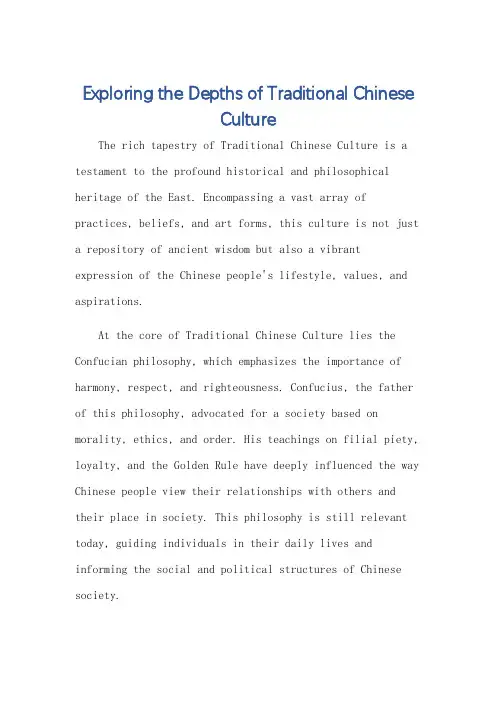
Exploring the Depths of Traditional ChineseCultureThe rich tapestry of Traditional Chinese Culture is a testament to the profound historical and philosophical heritage of the East. Encompassing a vast array of practices, beliefs, and art forms, this culture is not just a repository of ancient wisdom but also a vibrant expression of the Chinese people's lifestyle, values, and aspirations.At the core of Traditional Chinese Culture lies the Confucian philosophy, which emphasizes the importance of harmony, respect, and righteousness. Confucius, the father of this philosophy, advocated for a society based on morality, ethics, and order. His teachings on filial piety, loyalty, and the Golden Rule have deeply influenced the way Chinese people view their relationships with others and their place in society. This philosophy is still relevant today, guiding individuals in their daily lives and informing the social and political structures of Chinese society.Another important aspect of Traditional Chinese Culture is its rich artistic heritage. Chinese art, whether it be painting, calligraphy, pottery, or architecture, is renowned for its elegance, simplicity, and profound symbolism. The use of natural elements like water, stones, and flowers as motifs in art represents the Chineseaffinity with nature and their belief in the harmony of man with his surroundings. Calligraphy, in particular, is considered an extension of one's character and personality, with each stroke carrying deep meaning and emotional value. Music and dance are also integral to Chinese culture. Traditional Chinese instruments like the guqin, pipa, and drums create melodies that are both soothing and uplifting. These instruments, along with traditional dance forms like the dragon dance and lion dance, are often performed during festivals and special occasions, reflecting the joy and vitality of the Chinese people.The Chinese calendar is also a unique aspect of this culture, with each month, day, and season associated with specific meanings and celebrations. The Chinese New Year, for instance, is a time for family reunions, giving redenvelopes, and setting off fireworks to驱逐邪恶和迎来好运. These practices are deeply rooted in Chinese history and tradition, serving as a reminder of their cultural identity and heritage.In conclusion, Traditional Chinese Culture is a vast and diverse field that encompasses various aspects of life, from philosophy and art to music, dance, and festivals. This culture, with its unique blend of ancient wisdom and modern vitality, continues to inspire and influence people around the world, making it an integral part of global cultural heritage.**探寻中国传统文化的深厚底蕴**中国传统文化是一幅丰富多彩的织锦,见证了东方古老历史和哲学遗产的深厚底蕴。
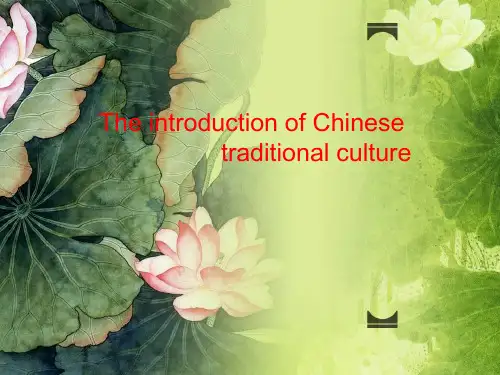
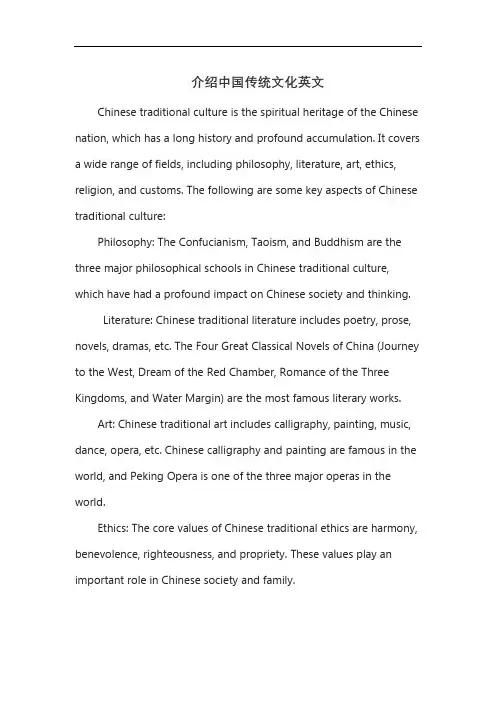
介绍中国传统文化英文Chinese traditional culture is the spiritual heritage of the Chinese nation, which has a long history and profound accumulation. It covers a wide range of fields, including philosophy, literature, art, ethics, religion, and customs. The following are some key aspects of Chinese traditional culture:Philosophy: The Confucianism, Taoism, and Buddhism are the three major philosophical schools in Chinese traditional culture, which have had a profound impact on Chinese society and thinking.Literature: Chinese traditional literature includes poetry, prose, novels, dramas, etc. The Four Great Classical Novels of China (Journey to the West, Dream of the Red Chamber, Romance of the Three Kingdoms, and Water Margin) are the most famous literary works.Art: Chinese traditional art includes calligraphy, painting, music, dance, opera, etc. Chinese calligraphy and painting are famous in the world, and Peking Opera is one of the three major operas in the world.Ethics: The core values of Chinese traditional ethics are harmony, benevolence, righteousness, and propriety. These values play an important role in Chinese society and family.Religion: Chinese traditional religion includes Buddhism, Taoism, and Islam. These religions have had a profound impact on Chinese society and culture.Custom: Chinese traditional customs include Spring Festival, Mid-Autumn Festival, Dragon Boat Festival, etc. These customs reflect the cultural traditions and values of the Chinese nation.In short, Chinese traditional culture is a rich and diverse cultural system that has had a profound impact on Chinese society and the world. It is the spiritual pillar of the Chinese nation and an important part of world culture.。

介绍中国传统文化的英语作文(五年级) Introduction to Chinese Traditional CultureChina is a country with a rich history and diverse cultural traditions. Chinese traditional culture has a long history, spanning thousands of years, and has had a profound influence on the development of Chinese society and civilization.One of the most important aspects of Chinese traditional culture is Confucianism, which emphasizes the importance of family, respect for elders, loyalty to one's country, and the cultivation of personal virtues such as benevolence, righteousness, and propriety. Confucianism has played a significant role in shaping Chinese society and ethics, and continues to have a strong influence on Chinese cultural values and social norms.Another important aspect of Chinese traditional culture is Taoism, which emphasizes the harmony between man and nature, the cultivation of inner peace and tranquility, and the pursuit of spiritual enlightenment. Taoist philosophy has had a profound impact on Chinese art, literature, and medicine, and continues to inspire people to seek balance and harmony in their lives.Chinese traditional culture also places a strong emphasis on the importance of filial piety, or the respect and devotion that children should show towards their parents and ancestors. Filial piety is considered one of the most important virtues in Chinese society, and is seen as the foundation of moral conduct and social order.In addition to Confucianism, Taoism, and filial piety, Chinese traditional culture also includes a rich tradition of literature, art, music, dance, and cuisine. Chinese literature, for example, includes classics such as the Analects of Confucius, the Tao Te Ching, and the Romance of the Three Kingdoms, which have had a profound impact on Chinese culture and society.Chinese traditional art forms such as calligraphy, painting, sculpture, and architecture are also highly valued for their beauty, elegance, and spiritual depth. Chinese calligraphy, for example, is considered a high art form that requires skill, discipline, and a deep understanding of Chinese culture and philosophy.Chinese traditional music and dance are also an important part of Chinese culture, and include a wide variety of styles and genres that reflect the diversity and richness of Chinese society. Chinese cuisine, with its emphasis on fresh ingredients, delicateflavors, and beautiful presentation, is also highly regarded for its delicious taste and health benefits.In conclusion, Chinese traditional culture is a rich and diverse tradition that has deep roots in Chinese history and society. It reflects the values, beliefs, and attitudes of the Chinese people, and continues to play an important role in shaping Chinese identity and promoting cultural heritage. By learning more about Chinese traditional culture, we can gain a better understanding of the values and beliefs that have shaped Chinese society and civilization for thousands of years.。
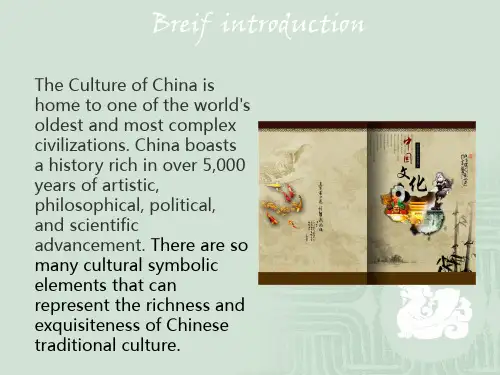

中国传统文化英语作文 1With the rapidly developing of the society ,culture have changed greatly.In the city, no one can escape from the fast pace.And as a result, the traditional culture are believed becoming lost.However ,why the traditional culture are becoming lost?First, we eatculture. Since we get used to such fast things that many traditional things have been ignored.Second, we have brought up many other cultures,those culture are more popular than our owe culture for the young people ,they interest in the other cultures because those cultures are new things and the youngs are curious about newthings 。
And young people stand for the future culture So many people believe that the traditional culture will gradually be lost.To some traditional cultures that are on decline, we have taken active measures to conserve them. Experts have come up with proper advice on protecting such cultures. Many volunteers have dedicated themselves to studying them. First and foremost,more and more people have discerned the importance of the traditional culture. Therefore, we are sure that our efforts will lead to a brilliant future.If a culture wants to gain an eternal life, it should change itself to cater to the people in its age. So does our traditional culture. Traditional cultures adhering to modern means appear rigorous. For example, we make CDs for classic music so that it can not only meet modern needs but also spread further and more successfully in the modern world. The appearance of traditional culture changes, but the essence will never change and will be well accepted.随着社会的快速发展,文化发生了巨大的变化。
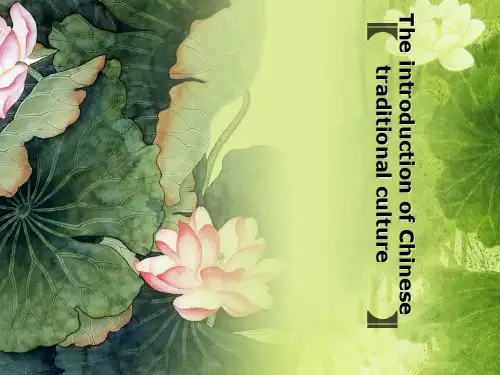
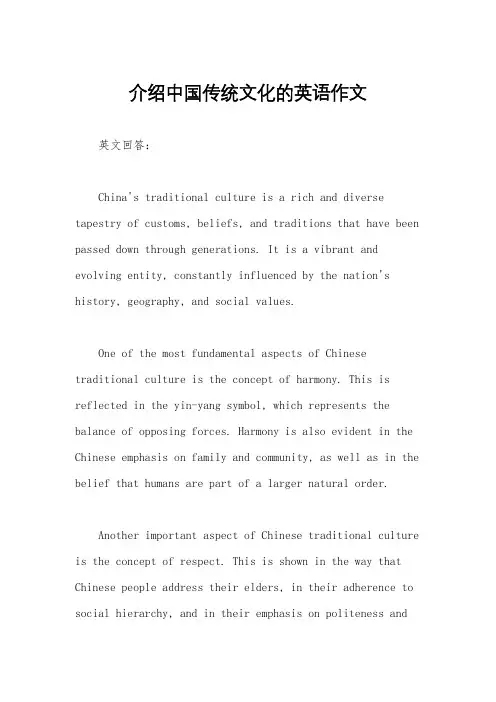
介绍中国传统文化的英语作文英文回答:China's traditional culture is a rich and diverse tapestry of customs, beliefs, and traditions that have been passed down through generations. It is a vibrant and evolving entity, constantly influenced by the nation's history, geography, and social values.One of the most fundamental aspects of Chinese traditional culture is the concept of harmony. This is reflected in the yin-yang symbol, which represents the balance of opposing forces. Harmony is also evident in the Chinese emphasis on family and community, as well as in the belief that humans are part of a larger natural order.Another important aspect of Chinese traditional culture is the concept of respect. This is shown in the way that Chinese people address their elders, in their adherence to social hierarchy, and in their emphasis on politeness andgood manners. Respect is also extended to the environment, as the Chinese believe that humans are responsible for preserving the natural world.Chinese traditional culture is also known for its emphasis on tradition and ritual. This is evident in the way that Chinese people celebrate holidays, such as the Spring Festival and the Mid-Autumn Festival. It is also seen in the way that Chinese people observe customs such as ancestor worship and filial piety.Finally, Chinese traditional culture is renowned forits artistic achievements. This includes the development of calligraphy, painting, music, and dance. Chinese art is often characterized by its beauty, elegance, and symbolism.中文回答:中国传统文化博大精深,源远流长,是中华民族在漫长的历史进程中创造和积累的宝贵遗产。
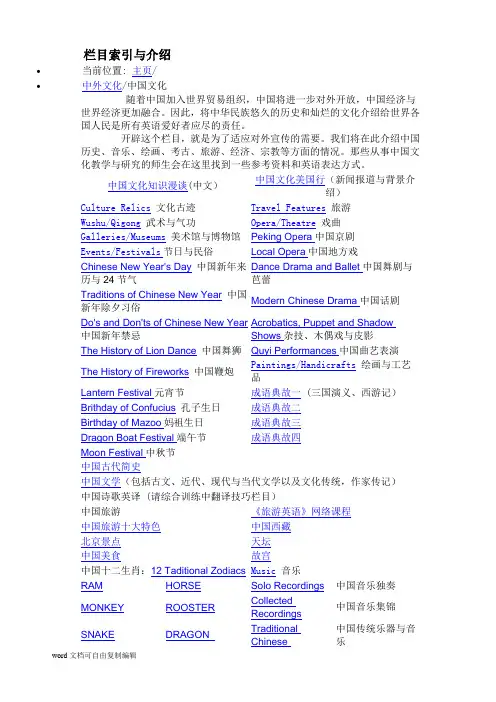
栏目索引与介绍•当前位置: 主页/•中外文化/中国文化随着中国加入世界贸易组织,中国将进一步对外开放,中国经济与世界经济更加融合。
因此,将中华民族悠久的历史和灿烂的文化介绍给世界各国人民是所有英语爱好者应尽的责任。
开辟这个栏目,就是为了适应对外宣传的需要。
我们将在此介绍中国历史、音乐、绘画、考古、旅游、经济、宗教等方面的情况。
那些从事中国文化教学与研究的师生会在这里找到一些参考资料和英语表达方式。
中国文化知识漫谈(中文)中国文化美国行(新闻报道与背景介绍)Culture Relics文化古迹Travel Features旅游Wushu/Qigong武术与气功Opera/Theatre戏曲Galleries/Museums美术馆与博物馆Peking Opera中国京剧Events/Festivals节日与民俗Local Opera中国地方戏Chinese New Year's Day中国新年来历与24节气Dance Drama and Ballet中国舞剧与芭蕾Traditions of Chinese New Year中国新年除夕习俗Modern Chinese Drama中国话剧Do's and Don'ts of Chinese New Year 中国新年禁忌Acrobatics, Puppet and Shadow Shows杂技、木偶戏与皮影The History of Lion Dance中国舞狮Quyi Performances中国曲艺表演The History of Fireworks中国鞭炮Paintings/Handicrafts绘画与工艺品Lantern Festival元宵节成语典故一 (三国演义、西游记)Brithday of Confucius孔子生日成语典故二Birthday of Mazoo妈祖生日成语典故三Dragon Boat Festival端午节成语典故四Moon Festival中秋节中国古代简史中国文学(包括古文、近代、现代与当代文学以及文化传统,作家传记)中国诗歌英译 (请综合训练中翻译技巧栏目)中国旅游《旅游英语》网络课程中国旅游十大特色中国西藏北京景点天坛中国美食故宫中国十二生肖:12 Taditional Zodiacs M usic音乐RAM HORSE Solo Recordings中国音乐独奏MONKEY ROOSTER CollectedRecordings中国音乐集锦SNAKE DRAGON TraditionalChinese中国传统乐器与音乐InstrumentalmusicDOG PIG Classical Music中国古典音乐OX TIGERRABBIT RAT中国文化知识漫谈(一)文化的含义什么叫文化?《易经》上说:“观乎天文,以察时变,观乎人文,以化成天下。
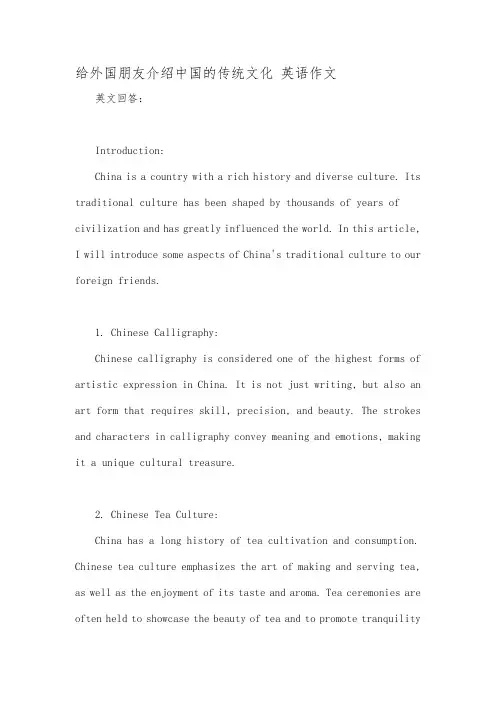
给外国朋友介绍中国的传统文化英语作文英文回答:Introduction:China is a country with a rich history and diverse culture. Its traditional culture has been shaped by thousands of years of civilization and has greatly influenced the world. In this article, I will introduce some aspects of China's traditional culture to our foreign friends.1. Chinese Calligraphy:Chinese calligraphy is considered one of the highest forms of artistic expression in China. It is not just writing, but also an art form that requires skill, precision, and beauty. The strokes and characters in calligraphy convey meaning and emotions, making it a unique cultural treasure.2. Chinese Tea Culture:China has a long history of tea cultivation and consumption. Chinese tea culture emphasizes the art of making and serving tea, as well as the enjoyment of its taste and aroma. Tea ceremonies are often held to showcase the beauty of tea and to promote tranquilityand harmony.3. Chinese Martial Arts:Chinese martial arts, also known as Wushu, have a history of thousands of years. It is not only a physical exercise but also a way to cultivate the mind and spirit. Martial arts such as Tai Chi and Kung Fu are not only about self-defense but also promote discipline, balance, and inner peace.4. Festivals and Traditions:China has numerous traditional festivals that are celebrated with great enthusiasm. The Spring Festival (Chinese New Year), the Lantern Festival, and the Mid-Autumn Festival are some of the most significant ones. These festivals are characterized by vibrant decorations, delicious food, and various cultural activities.Conclusion:China's traditional culture is a treasure trove of wisdom, art, and spirituality. By understanding and appreciating its richness, we can gain a deeper insight into the Chinese way of life. I hope this introduction to China's traditional culture has piqued your interest and encouraged you to explore further.中文回答:简介:中国是一个拥有悠久历史和多元文化的国家。
Introduction about traditional Chinese culture China is a country with a rich and diverse cultural heritage, which spans thousands of years. Some of the most notable aspects of Chinese traditional culture include tea culture, porcelain, and Beijing opera.Tea culture is an integral part of Chinese life and has a long and fascinating history. Tea was first developed in China over 5,000 years ago, and since then it has played a significant role in Chinese culture. To the Chinese, making and serving tea is an art form that requires great skill and expertise. The traditional tea ceremony involves a series of precise and elegant movements, and is highly ritualized.Porcelain is another important aspect of Chinese traditional culture. The Chinese were the first to develop porcelain, which is made from a combination of kaolin, feldspar, and quartz. Porcelain is prized for its beauty, its intricate patterns, and its incredible durability. The best-known type of Chinese porcelain is blue and white porcelain, which is decorated with intricate blue designs on a white background.Beijing opera is one of the most famous forms of Chinese traditional culture. It incorporates singing, dancing, and martial arts, and is highly stylized and symbolic. Beijing opera has a long and illustrious history,and is considered by many to be the quintessential example of Chinese performance art. The elaborate costumes, makeup, and stage sets are all designed to create a magical, otherworldly atmosphere.Chinese calligraphy is another notable aspect of traditional Chinese culture. Calligraphy is the art of writing Chinese characters and is a highly respected and valued skill in China. Calligraphy was first developed over 2,000 years ago, and since then it has been used as a form of artistic expression and as a means of communicating important ideas and thoughts.In conclusion, Chinese traditional culture is a rich and fascinating topic that encompasses a wide range of artistic and cultural forms. From tea culture to porcelain to Beijing opera, these cultural treasures represent the very best of what China has to offer. To truly appreciate Chinese culture, one must take the time to explore and appreciate these extraordinary traditions.。
用英语介绍中国传统文化pdf全文共3篇示例,供读者参考篇1Introduction to Traditional Chinese CultureChinese culture is one of the oldest and richest in the world, with a history that dates back thousands of years. It encompasses a wide range of traditions, customs, and practices that have been passed down through generations. In this document, we will explore some of the key aspects of traditional Chinese culture, including art, literature, philosophy, and food.ArtChinese art is diverse and multifaceted, encompassing a wide range of styles and mediums. Traditional Chinese painting, calligraphy, and pottery are highly esteemed for their beauty and elegance. Chinese artists often draw inspiration from nature, with landscapes, flowers, and animals being popular subjects. Traditional Chinese paintings are characterized by their use of brush strokes, ink washes, and vibrant colors.LiteratureChinese literature is one of the oldest and most influential in the world. The Chinese language is rich and expressive, allowing for a wide range of literary forms, including poetry, prose, and drama. Classic works such as "The Art of War" by Sun Tzu, "Journey to the West" by Wu Cheng'en, and "Dream of the Red Chamber" by Cao Xueqin are widely regarded as masterpieces of Chinese literature.PhilosophyChinese philosophy is deeply rooted in ancient texts such as the Confucian Analects, the Dao De Jing, and the works of Mencius. Confucianism, Daoism, and Buddhism are the three main philosophical traditions in China, each with its own unique beliefs and practices. Confucianism emphasizes moral values, filial piety, and social harmony, while Daoism focuses on living in harmony with nature and finding inner peace. Buddhism teaches the importance of compassion, mindfulness, and enlightenment.FoodChinese cuisine is known for its variety, flavor, and health benefits. Traditional Chinese cooking techniques includestir-frying, steaming, and braising, which help to preserve the natural flavors and nutrients of the ingredients. Popular ingredients in Chinese cuisine include rice, noodles, tofu,vegetables, and a wide range of meats and seafood. Some of the most famous Chinese dishes include Peking duck, dim sum, hot pot, and Mapo tofu.ConclusionTraditional Chinese culture is a rich and vibrant tapestry of art, literature, philosophy, and food. It has been shaped by thousands of years of history and continues to evolve and adapt in the modern world. By exploring the key aspects of Chinese culture, we can gain a deeper understanding of this ancient and fascinating civilization.篇2Introduction to Chinese Traditional CultureChinese traditional culture has a long history and has greatly influenced the development of Chinese society. It has accumulated and evolved over thousands of years, reflecting the wisdom, customs, values, and beliefs of the Chinese people. In this PDF, we will introduce some of the key aspects of Chinese traditional culture.1. ConfucianismConfucianism is a philosophical and ethical system that was founded by Confucius in the 5th century BC. It emphasizes the importance of moral values, social harmony, respect for elders, and the maintenance of proper relationships in society. Confucianism has had a profound impact on Chinese politics, education, and culture.2. TaoismTaoism is a philosophical and religious tradition that originated in China in the 4th century BC. It emphasizes living in harmony with the Tao, or the natural way of the universe. Taoist practices include meditation, martial arts, and the study of alchemy. Taoism has influenced Chinese art, literature, and medicine.3. Chinese CalligraphyChinese calligraphy is a highly esteemed art form in China that involves writing Chinese characters with a brush and ink. Calligraphy is considered a reflection of the calligrapher's personality and skill. It is often used in traditional Chinese painting, poetry, and seal carving.4. Chinese OperaChinese opera is a traditional form of performing arts that combines music, singing, acting, and acrobatics. There are several regional styles of Chinese opera, including Peking opera, Cantonese opera, and Sichuan opera. Chinese opera often depicts historical events, legends, and myths.5. Chinese FestivalsChinese festivals are an important part of traditional Chinese culture. Some of the most popular festivals include the Chinese New Year, the Lantern Festival, the Dragon Boat Festival, and the Mid-Autumn Festival. These festivals are celebrated with traditional customs, food, and performances.ConclusionChinese traditional culture is rich and diverse, encompassing a wide range of beliefs, practices, and art forms. It has been passed down from generation to generation and continues to be celebrated and cherished by the Chinese people. By studying and preserving Chinese traditional culture, we can gain a deeper understanding of the values and beliefs that have shaped Chinese society for centuries.篇3Chinese traditional culture is a rich and diverse heritage that has been passed down through generations. From literature and art to philosophy and customs, Chinese traditional culture encompasses a wide range of practices and beliefs that have shaped the country's identity.One of the most well-known aspects of Chinese traditional culture is Confucianism, a philosophy founded by Confucius that emphasizes the importance of ethical values such as benevolence, righteousness, and filial piety. Confucianism has had a profound influence on Chinese society, shaping everything from family relationships to government policies.Another important part of Chinese traditional culture is Chinese calligraphy, which is considered a high art form in China. Calligraphy has a long history in China, dating back thousands of years, and is prized for its beauty and expressiveness. Chinese calligraphy is not just a form of writing, but also a way of expressing one's emotions and personality.In addition to Confucianism and calligraphy, Chinese traditional culture also includes traditional Chinese medicine, martial arts, and traditional festivals such as the Chinese New Year and the Mid-Autumn Festival. These practices and beliefsare deeply rooted in Chinese society and continue to be celebrated and practiced by millions of people around the world.For those interested in learning more about Chinese traditional culture, there are many resources available, including books, websites, and PDF documents. These resources can provide valuable insights into the history, customs, and beliefs of Chinese traditional culture, allowing readers to gain a deeper understanding of this rich and vibrant heritage.In conclusion, Chinese traditional culture is a treasure trove of wisdom, artistry, and tradition that has been passed down through the ages. By exploring and learning about Chinese traditional culture, we can gain a greater appreciation for the values and beliefs that have shaped Chinese society for centuries.。
英文中国传统文化介绍Chinese traditional culture is a rich tapestry woven through thousands of years of history, embodying philosophies, arts, social structures, and rituals that have shaped the identity and worldview of its people. Central to this culture are Confucianism, Taoism, and Buddhism, which have influenced ethics, governance, and personal cultivation.Confucianism, founded by Confucius in the 6th century BCE, emphasizes personal and governmental morality, justice, kindness, and virtue. It promotes a harmonious society秩序through proper behavior and respect for family and social roles.Taoism, attributed to Lao Tzu, focuses on living in harmony with the Tao, or the way of the universe. It encourages simplicity, naturalness, and spontaneity, influencing art, medicine, and martial arts such as Tai Chi.Buddhism, introduced from India, teaches the path to enlightenment through meditation and the elimination of desire. It has profoundly impacted Chinese art, literature, and the development of Zen Buddhism.The written language, with its logographic characters, remains largely unchanged and is considered a bridge to ancientwisdom. Literature spans classic poetry, prose, and more modern forms, reflecting cultural values and historical events.Chinese visual arts are renowned for calligraphy, painting, and porcelain. Calligraphy is an art form in itself, with different styles conveying varying moods and energies. Painting often features landscapes, bamboo, orchids, and other natural elements, symbolizing harmony and longevity. Porcelain, known as 'china', is prized for its beauty and craftsmanship.Architecture is marked by the use of timber frames, upturned eaves, and traditional gardens that blend seamlessly with nature. The Forbidden City in Beijing and the Terracotta Army near Xi'an are testaments to the grandeur and sophistication of ancient construction.Food is another essential aspect, with a cuisine that varies by region and uses techniques like stir-frying, deep-frying, steaming, and braising. Ingredients such as rice, noodles, soy, ginger, and tea are staples.Traditional festivals like the Spring Festival (Chinese New Year), Mid-Autumn Festival, and Dragon Boat Festival are occasions for feasting, family reunions, and the preservation of customs. Each festival has its own set of traditions, such as setting off fireworks, giving red envelopes, and eatingmooncakes.Martial arts, including Kung Fu and Tai Chi, have evolved over centuries, not only as combat systems but also as disciplines for physical health and mental well-being.In summary, Chinese traditional culture is a profound legacy that continues to influence not only the daily lives of its people but also the global understanding of human civilization. Its enduring principles and practices offer insights into balance, harmony, and the human relationship with the natural world.。
6个简短介绍中国传统文化英语作文全文共3篇示例,供读者参考篇1China has a rich and diverse traditional culture that has been developed over thousands of years. Here are 6 brief introductions to some aspects of traditional Chinese culture:1. Confucianism: Confucianism is a philosophy and ethical system that was founded by Confucius in the 6th century BC. It emphasizes the importance of moral values, family loyalty, and social harmony. Confucianism has had a profound influence on Chinese society, shaping its values and beliefs.2. The Four Great Inventions: The Four Great Inventions of ancient China are considered to be the compass, gunpowder, papermaking, and printing. These inventions have had a lasting impact on world history and have significantly contributed to the development of human civilization.3. Chinese Calligraphy: Chinese calligraphy is a revered art form that dates back to ancient times. It involves the use of brush and ink to create beautiful and intricate characters on paper.Calligraphy is not only a form of writing but also a means of self-expression and artistic creation.4. Traditional Chinese Medicine: Traditional Chinese medicine is a holistic approach to health and well-being that has been practiced for thousands of years. It includes therapies such as acupuncture, herbal medicine, and qigong. Traditional Chinese medicine focuses on balancing the body's energy and promoting overall health.5. Chinese Tea Culture: Tea has been an integral part of Chinese culture for centuries. China is known for producing some of the finest teas in the world, such as green tea, oolong tea, and pu-erh tea. Tea is not only a popular beverage but also a symbol of hospitality, friendship, and refinement.6. Chinese Festivals: Chinese festivals are an important part of traditional culture and are celebrated with great enthusiasm and excitement. Some of the most popular festivals include Chinese New Year, Mid-Autumn Festival, and Dragon Boat Festival. These festivals are marked by colorful decorations, traditional foods, and lively performances.Overall, China's traditional culture is characterized by its richness, diversity, and longevity. It has played a significant rolein shaping Chinese identity and continues to be a source of pride and inspiration for people around the world.篇2Chinese traditional culture has a long and rich history that dates back thousands of years. It is a unique and complex system of beliefs, customs, rituals, and arts that have been passed down through generations. In this essay, we will briefly introduce six key aspects of Chinese traditional culture.1. Confucianism: Confucianism is one of the most important philosophical and ethical teachings in Chinese culture. It was founded by Confucius (551-479 BC) and emphasizes the importance of moral values, social harmony, and filial piety. Confucianism has greatly influenced Chinese society and has played a significant role in shaping Chinese values and traditions.2. Taoism: Taoism is another major philosophical and spiritual tradition in China. It is based on the teachings of Laozi, who is believed to have lived in the 6th century BC. Taoism emphasizes living in harmony with the natural world, cultivating inner peace, and following the Tao (the way or path). Taoist practices include meditation, qigong, and the study of the Tao Te Ching.3. Chinese Calligraphy: Chinese calligraphy is an ancient art form that has been practiced for thousands of years. It is considered one of the highest forms of visual art in Chinese culture and is highly regarded for its aesthetic beauty and expressive power. Chinese calligraphy is often associated with mindfulness, discipline, and self-expression.4. Chinese Opera: Chinese opera is a traditional performing art that combines music, dance, acrobatics, and acting. It has a history of over 1,000 years and includes various regional styles such as Beijing opera, Cantonese opera, and Sichuan opera. Chinese opera is known for its colorful costumes, intricate makeup, and stylized movements.5. Traditional Festivals: Chinese traditional culture is also celebrated through a wide range of festivals that mark important events in the lunar calendar. Some of the most well-known festivals include Chinese New Year, the Mid-Autumn Festival, and the Dragon Boat Festival. These festivals are a time for family reunions, cultural activities, and the honoring of ancestors.6. Feng Shui: Feng Shui is an ancient Chinese practice that involves arranging the environment in a way that promotes harmony and balance. It is based on the belief that the arrangement of objects and spaces can influence the flow of qi(energy) and improve one's well-being. Feng Shui is commonly used in architecture, interior design, and landscaping.In conclusion, Chinese traditional culture is a multifaceted and dynamic system that reflects the values, beliefs, and customs of the Chinese people. It has withstood the test of time and continues to be a source of inspiration and pride for millions of people around the world. By learning more about Chinese traditional culture, we can gain a deeper understanding of the rich heritage and legacy of this ancient civilization.篇3Traditional Chinese culture is rich and diverse, reflecting the long history and unique heritage of China. Here are 6 brief introductions to different aspects of traditional Chinese culture.1. Confucianism: Confucianism is one of the most important traditions in Chinese culture. It is a philosophical and ethical system based on the teachings of Confucius, a Chinese philosopher who lived over 2,500 years ago. Confucianism emphasizes the importance of family, social harmony, respect for elders, and moral integrity. These values have had a profound impact on Chinese society and continue to shape Chinese culture to this day.2. Chinese calligraphy: Chinese calligraphy is a highly respected art form in China. It involves writing Chinese characters with a brush and ink in a way that emphasizes beauty, balance, and rhythm. Calligraphy is not just a means of communication but also a form of artistic expression. Many Chinese people practice calligraphy as a way to cultivate their inner selves and appreciate the beauty of the written word.3. Chinese painting: Chinese painting is another important aspect of traditional Chinese culture. It is characterized by its use of brush and ink to create delicate and expressive artworks. Chinese paintings often depict landscapes, nature, flowers, and animals in a style that emphasizes simplicity and harmony. Chinese painting has a long history and has influenced the development of other art forms around the world.4. Chinese tea culture: Tea has been an integral part of Chinese culture for thousands of years. Chinese tea culture is known for its emphasis on the art of tea-making, the appreciation of different types of tea, and the social rituals surrounding tea-drinking. In China, tea is more than just a beverage – it is a symbol of hospitality, friendship, and respect. Many Chinese people see tea-drinking as a way to relax, socialize, and connect with nature.5. Chinese cuisine: Chinese cuisine is renowned for its diversity, flavor, and technique. Chinese food is characterized by its use of fresh ingredients, balance of flavors, and variety of cooking methods. Each region of China has its own culinary traditions and specialties, reflecting the country's vast geography and diverse cultural heritage. Chinese cuisine is not only delicious but also symbolic, with certain foods being associated with luck, prosperity, and happiness.6. Traditional Chinese medicine: Traditional Chinese medicine is an ancient system of healthcare that has been practiced in China for thousands of years. It includes practices such as acupuncture, herbal medicine, massage, and qigong. Traditional Chinese medicine is based on the principles of balance, harmony, and the interconnectedness of the mind, body, and spirit. Many Chinese people use traditional Chinese medicine as a holistic approach to health and wellness, complementing modern medical treatments.In conclusion, traditional Chinese culture encompasses a wide range of practices, beliefs, and art forms that have been passed down through generations. These aspects of Chinese culture continue to be cherished and celebrated by people inChina and around the world, reflecting the enduring appeal and relevance of traditional Chinese culture.。